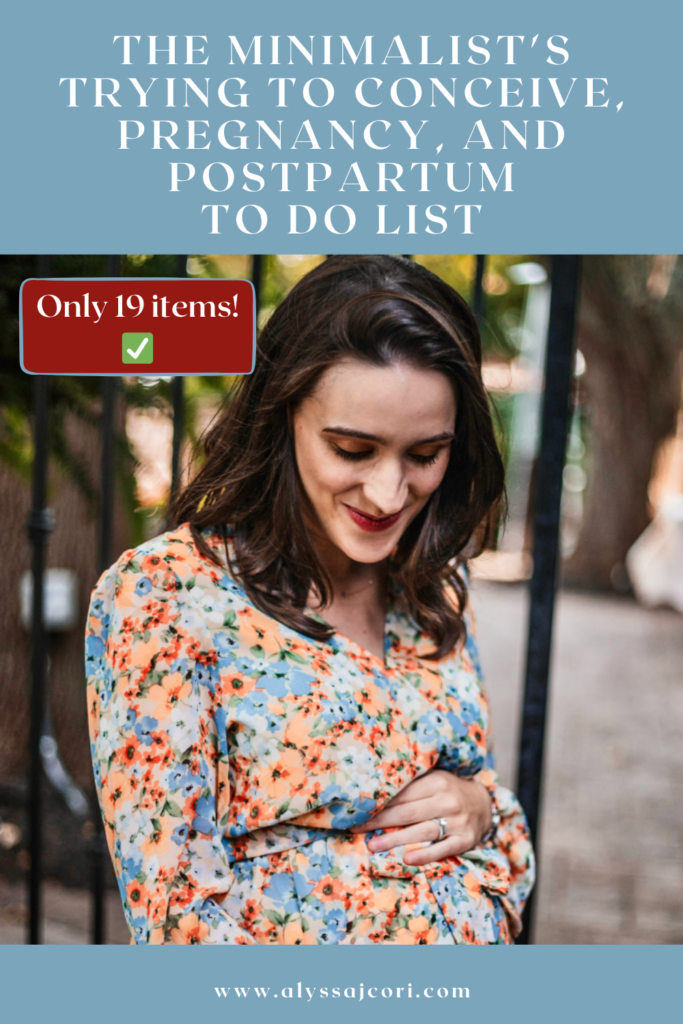When I was planning to get pregnant, going through my pregnancy, and in the first few weeks of my postpartum experience, a common theme was that I wanted to simplify. To do the minimum. To not feel overwhelmed with what I “should” be doing, and instead to focus on just what was essential. This is how I tend to feel in every area of my life to begin with, but there is so much out there about pregnancy (and countless “to do lists”) that I didn’t know what to believe.

Now that I’ve gone through it, this is the simplified, it’s really not that big of a deal guide to pregnancy. I hope these resources are helpful and, if nothing else, inspire you to chill out and embrace doing the minimum.
Trying to Conceive
✅ Discuss your plans with your doctor
At your annual appointment (or a separate appointment if you have specific fertility concerns and the timing doesn’t line up with your annual appointment) talk with your doctor about your timeline and plans for trying to get pregnant and see if they have any advice specific to your case.
✅ Download Premom, buy ovulation strips and a basal thermometer
I started using the Premom app (the free version), ovulation strips, and a basal thermometer a month before trying to get pregnant. All of these work well together and are super simple to use to get a baseline understanding of your fertility when you stop your method of birth control and when actively trying to conceive.
✅ Read What to Expect Before You’re Expecting by Heidi Murkoff
This book is a great guide to understand the basics of fertility and how you can prep your body and mind for trying to conceive and pregnancy.
✅ Start taking a prenatal vitamin
Replace your regular multivitamin with a prenatal. I used this affordable one from Target. Check with your doctor if they have a recommended vitamin.
During Pregnancy
✅ Confirm your pregnancy and schedule your appointments
Once you take an at home pregnancy test (which you’ll know exactly when to take because of the Premom app and tools) and get a positive result, you’ll make an appointment with your doctor to confirm your pregnancy and schedule the appointments and test that they recommend. I found it helpful to have one place to jot down questions so I wouldn’t forget for my next visit. You can do this in a note on your phone or use the excuse to get a cute notebook.
You should also schedule a visit with your dentist – oral care is important in pregnancy!
✅ Read What to Expect When You’re Expecting By Heidi Murkoff, Expecting Better by Emily Oster, and Bringing Up Bebe by Pamela Druckerman
There are so many books that you can read on the topic of pregnancy. What to Expect is a classic, and it pairs nicely with Expecting Better which is a data heavy book with an updated view on the standard pregnancy wisdom and recommendations. Bringing Up Bebe helped me when it came to envisioning what my life could look like once the baby arrived and gave me a positive mindset about how motherhood can be whatever you want it to be.
✅ Download The Bump app
If you enjoy knowing what your body is doing each week and how your baby is growing, I loved The Bump’s app. It was a fun way to see how the baby was developing between doctor appointments and it was one, simple place to go each week for information.
✅ Take care of your body: Prenatal yoga, Belly oil, pelvic floor
Aside from the obvious of cutting out harmful substances (not only in your diet, but also your skincare and beauty products) and eating well, when it comes to physical care I really enjoyed doing prenatal yoga from Boho Beautiful (here’s one video. You can search YouTube and the Boho Beautiful app for more, plus she has a complete program you can buy). I also used a belly oil from Burt’s Bees and did some basic pelvic floor exercises.
✅ Don’t bother buying much
I’ll give the disclaimer that everyone is different, but I really did not find that I needed to buy much for pregnancy. I didn’t need any special pillows or new bras or a completely new wardrobe. Instead I found that I could buy a few clothing pieces a size up and the only “maternity” clothing I got was leggings (to be fair, I was mostly pregnant in the summer and fall, so I’m sure my experience could have been different in the winter). This is not to say that getting maternity clothing is a bad idea or that it’s something to be avoided! My advice is to just take your purchases a day at a time and don’t immediately buy into the hype of needing new things – just wait and see what you actually need.
✅ Understand your insurance coverage, decide on a pediatrician
Make sure you understand what tests and appointments your insurance covers and what providers are in-network at the hospital you plan to use. You can either read your insurance policy or call your insurance company to talk it through and get questions answered.
You’ll also need to decide on a pediatrician. Keep this simple. You don’t have to visit 10 to make a decision. Ask your doctor and a few friends and family for recommendations, narrow your options down based on proximity to your home, and visit one or two. You can always change later if you need to.
✅ Understand your leave options from work and communicate with your team
Waiting until you are in the second trimester is a standard practice before announcing your pregnancy at work. Before you do, you can check your company’s policy on maternity leave and make a plan for how you want to communicate with your manager and how you will support your team leading up to your absence.
✅ Share the good news!
This can be as simple or complicated as you want (if you’re reading this post, I’ll assume you want uncomplicated!). It so happened that we were already planning to do a photo shoot while on vacation that we turned into a pregnancy announcement by holding our sonogram pictures for a few shots. We shared these photos with our families in person, called our friends, and considered the job done.
✅ Register on Babylist
I’ll have a complete post coming on a minimalist baby registry. I used and really liked Babylist because you can add items from all different retailers.
✅ Prepare for birth: Don’t worry about classes or making a “birth plan”
I think Joe said it best, “they’ll tell us what we need to do as it’s happening.” We watched a video on the basics of labor and thought about the standard questions like if I wanted an epidural and if we wanted the baby circumcised if it was a boy, but you definitely do not need to write out a plan or take a class.
First of all, if you are working with providers you trust, they will be guiding you through every step. Second, you can’t really plan your labor and delivery. I had an unexpected induction and delivery 3 weeks early because of a complication that would not have been in any plan I had written.
✅ Have a place for the baby to be changed and sleep
You don’t need to have the nursery completely decorated. You don’t need outfits organized for the first 6 months of their life. All you need is a safe place for the baby to sleep and supplies to change them. Having a glider chair is also a really good idea for feeding and for inevitably sleeping in while it’s your overnight shift in the nursery.
✅ Pack your hospital bag
This does not need to be done weeks in advance. You do not need a suitcase. This can be so SIMPLE and everything can go in a small duffle bag!
- A book (or your choice of entertainment)
- Headphones
- Phone charger
- A robe
- A going home outfit for you
- A going home outfit for the baby
- Cosmetics (whatever skincare and makeup you want. My hospital encouraged waiting to get home to shower), toothbrush, hairbrush, elastics
- Wallet (for id, insurance card – consider just brining your normal purse)
- A pillow
That’s it. Really. You don’t need snacks (you can’t eat during labor anyway, and you’ll get meals at the hospital after you give birth), you don’t need slippers, you don’t need maternity underwear. I will say, I’m not sure what you need if you are breastfeeding (like a breastfeeding bra), so that’s something additional to consider.
You also don’t need a postpartum recovery kit. I thought I would need that, but held off on getting it. Turns out, absolutely everything is provided by the hospital, including pads and disposable underwear. You may want to consider buying pads to have more at home that you’ll inevitably need over the next few weeks and strong pain medication.
Postpartum
✅ Be prepared to be out of whack & Set boundaries
I was completely thrown off by how not myself I felt. I understood that I would have a hormonal drop and that I would be sleep deprived and that I would feel extra emotional, but oh my goodness those first 2-3 weeks were a blindside for me. I was weepy, I was angry, I was all over the place. Knowing that it’s normal and that it will in fact pass can help your mindset immensely. As can having a great support system around you.
When you go to your 6 week check in with your doctor, that is an ideal time to discuss how you’re feeling (but don’t be afraid to ask for help sooner if you need it!).
Setting boundaries around topics like visitors, or what you need in a day to feel like yourself, or anything else is essential. The first few weeks are wild, so don’t be afraid to have boundaries and to recognize that your opinion on any given topic will likely change from day to day.
✅ Download the Huckleberry App
Everything can become a blur, from how often the baby is eating to how long they are sleeping. From day one we used the Huckleberry app to track our baby’s activity. It was so helpful to stay on top of what was happening and when we traded off shifts in the night we didn’t need to update each other on what had happened, we could just look at the app.
Now we still love it because we can see at a glance how much our baby has eaten and slept in a day, and how long he’s been up so that we can easily make decisions about the next nap time and feeding (another post is coming soon with our strategy and resources for sleep. Spoiler: we don’t use the Huckleberry sleep recommendations or pay for the premium account).
When you create an account make sure to use your email and a password instead of an existing Google account so that you and your partner can log into the same Huckleberry account.
✅ Enjoy your family!
I found that the first 4 weeks were for falling in love with our baby and for just getting through each day. After the first month, then we were able to start establishing some sort of a routine, thinking about his sleep, and engaging around his development. Another blog post will be coming with detailed information about the best resources for the first 3 months!
There you have it – the minimalist to do list! You have 4 items for trying to conceive, 12 for pregnancy, and 3 for postpartum. It’s totally manageable to have a great pregnancy, prepare for your baby, and live your life too.




Leave a Reply